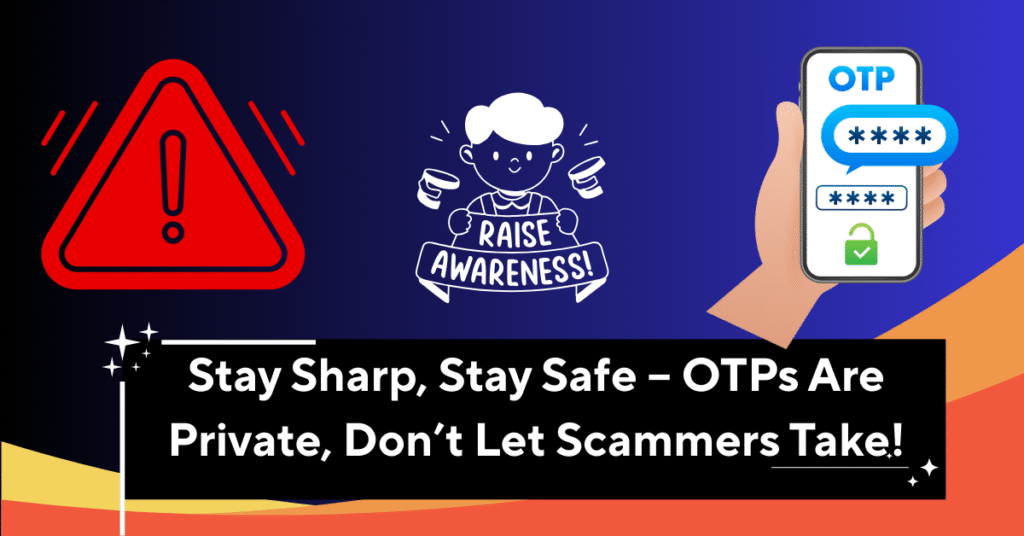Introduction
OTP (One-Time Password) scams are one of the most common cyber frauds today. Scammers trick victims into revealing OTPs, leading to unauthorized transactions, identity theft, and financial losses. According to the Indian Cyber Crime Report, OTP frauds account for over 30% of digital banking scams.
This guide will explain how OTP scams work, real-life examples, and actionable steps to protect yourself—backed by SEO and AEO (Answer Engine Optimization) best practices to ensure you get the most reliable and up-to-date information.
Table of Contents
- What is an OTP Scam?
- How Do OTP Scams Work? (Modus Operandi)
- Common Types of OTP Scams
- Real-Life OTP Scam Examples
- How to Stop OTP Scams? (10 Prevention Tips)
- What to Do If You’ve Fallen Victim?
- FAQs on OTP Scams (AEO-Optimized)
- Conclusion
1. What is an OTP Scam?
An OTP scam is a type of social engineering attack where fraudsters manipulate victims into sharing their One-Time Password (OTP), which is meant for secure verification. Once obtained, scammers can:
- Access bank accounts
- Make unauthorized transactions
- Steal personal data
- Take over social media accounts
Since OTPs are time-sensitive and meant for single use, sharing them gives criminals immediate access.

✔ Never Share OTP – Legitimate companies will never ask for OTPs.
✔ Verify Callers – Call the official customer care number to confirm any requests.
✔ Check SMS Details – Look for sender IDs
✔ Enable 2FA – Use app-based authentication (Google Authenticator) instead of SMS OTP where possible.
✔ Report Suspicious Activity – Inform your bank and cybercrime authorities immediately.
2. How Do OTP Scams Work? (Modus Operandi)
Scammers use psychological tricks to extract OTPs. Here’s how it typically happens:
Step 1: The Bait
- You receive a fake call/SMS/email pretending to be from a bank, courier service, or government agency.
- Example: “Your debit card is blocked. Share OTP to reactivate.”
Step 2: Creating Urgency
- Scammers create panic: “Your account will be frozen in 10 minutes!”
- Victims act hastily without verifying.
Step 3: OTP Extraction
- You receive a genuine OTP (triggered by the scammer trying to log in).
- The fraudster asks for it under a fake pretext (“This is a verification OTP”).
Step 4: Fraud Execution
- Once the OTP is shared, the scammer completes unauthorized transactions.
3. Common Types of OTP Scams
| Scam Type | How It Works |
|---|---|
| Fake Bank Calls | Caller claims to be from “customer care” and asks for OTP to “stop fraud.” |
| Delivery Scam | Fake SMS: “Your package is held; share OTP for delivery.” |
| UPI Fraud | Fraudster sends a payment request, then asks for OTP to “cancel” it. |
| SIM Swap Scam | Scammers port your number to a new SIM to intercept OTPs. |
| Fake Job Offers | “Share OTP to verify your bank for salary credit.” |
4. Real-Life OTP Scam Examples
Case 1: The “Bank Representative” Call
- A Mumbai resident lost ₹1.2 lakh after sharing an OTP with a caller claiming to be from his bank’s fraud department.
Case 2: Fake Amazon Delivery Scam
- A Delhi woman shared an OTP for a “failed delivery,” leading to ₹50,000 being siphoned from her UPI account.
5. How to Stop OTP Scams? (10 Prevention Tips)
✅ 1. Never Share OTP with Anyone
- Legitimate companies never ask for OTPs. If someone does, it’s a scam.
✅ 2. Verify Callers Independently
- If you get a suspicious call, hang up and call the official customer care number from the bank’s website.
✅ 3. Check SMS Sender IDs
- Genuine bank messages come from IDs like “ICICIBK” or “HDFCBK”, not random numbers.
✅ 4. Enable App-Based 2FA (Not SMS OTP)
- Use Google Authenticator or Authy for logins instead of SMS-based OTPs where possible.
✅ 5. Beware of Phishing Links
- Never click on links in messages like “Click here to stop fraud.”
✅ 6. Register for NPC’s Fraud Alerts
- The National Payments Corporation of India (NPCI) provides fraud alerts. Register via your bank.
✅ 7. Use UPI Lock Feature
- Enable UPI Auto-Pay Block in apps like PhonePe, GPay to prevent unauthorized debits.
✅ 8. Set Transaction Limits
- Reduce daily transaction limits to minimize losses if scammed.
✅ 9. Report Suspicious Activity Immediately
- Call your bank’s 24/7 helpline to block transactions.
✅ 10. Educate Family & Friends
- Many elderly people fall for OTP scams. Spread awareness!
6. What to Do If You’ve Fallen Victim?
- Call Your Bank Immediately – Report unauthorized transactions.
- Block Cards/UPI – Freeze your account via net banking.
- File a Cyber Complaint – Report at cybercrime.gov.in.
- Change Passwords – Secure email and banking logins.
7. FAQs on OTP Scams (AEO-Optimized)
❓ Can someone steal money with just an OTP?
Yes! OTPs authorize transactions. Never share them.
❓ What if I shared an OTP by mistake?
Immediately call your bank to block further transactions.
❓ Do banks refund money lost in OTP scams?
If reported quickly, banks may reverse fraudulent transactions, but no guarantee.
❓ How do fraudsters get my number for OTP scams?
From data leaks, phishing, or SIM swap fraud.
❓ Is it safe to click on OTP links in messages?
Never! Only enter OTPs on official websites/apps.
8. Conclusion
OTP scams exploit trust and urgency. By following never sharing OTPs, verifying callers, and using app-based 2FA, you can stay safe. Share this guide to protect others!
🔹 Pro Tip: Bookmark this page and check for updates, as scammers constantly evolve tactics.
#CyberSafety #OTPfraud #BankingScams #DigitalSecurity #FraudPrevention
